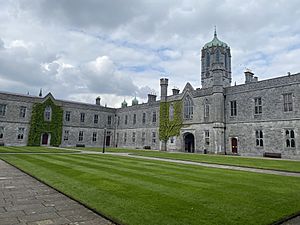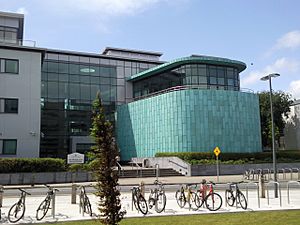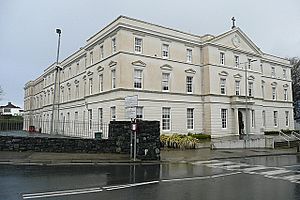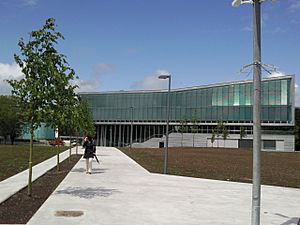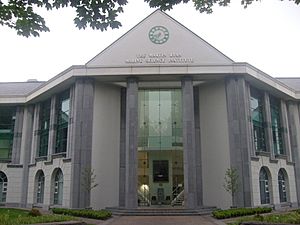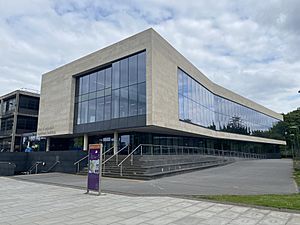University of Galway facts for kids
|
Ollscoil na Gaillimhe
|
||||||||||||
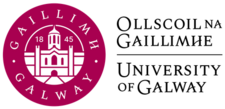 |
||||||||||||
|
Former names
|
|
|||||||||||
|---|---|---|---|---|---|---|---|---|---|---|---|---|
| Motto |
Deo Favente
|
|||||||||||
|
Motto in English
|
With the favour of God | |||||||||||
| Type | Public | |||||||||||
| Established | 30 December 1845 | |||||||||||
| Founder | Queen Victoria | |||||||||||
| Budget | €360 million (2022) | |||||||||||
| President | Peter McHugh | |||||||||||
| Chair of Údarás na hOllscoile | Máire Geoghegan-Quinn | |||||||||||
|
Academic staff
|
1,587 | |||||||||||
|
Total staff
|
2,650 | |||||||||||
| Students | 19,335 (2023/24) | |||||||||||
| Undergraduates | 14,405 (2023/24) | |||||||||||
| Postgraduates | 4,930 (2023/24) | |||||||||||
| Address |
University Road
,
,
H91 TK33
,
Ireland
53°16′44″N 9°03′36″W / 53.279°N 9.060°W |
|||||||||||
| Campus | Urban, 105 hectares (260 acres) | |||||||||||
| Language | English Irish |
|||||||||||
| Colours |
|
|||||||||||
| Affiliations |
|
|||||||||||
| Website | ||||||||||||
 |
||||||||||||
The University of Galway (Irish: Ollscoil na Gaillimhe) is a public research university. It is located in the city of Galway, Ireland.
The university started in 1845 as Queen's College, Galway. It was known as "University College, Galway" (UCG) from 1908 to 1997. From 1997 to 2022, it was called "National University of Ireland Galway" (NUI Galway). In September 2022, its name changed to "Ollscoil na Gaillimhe - University of Galway".
The University of Galway is part of the Coimbra Group. This is a group of 40 old and respected universities in Europe.
Contents
History of the University
The university was created in 1845 as Queen's College, Galway. Two other colleges, in Cork and Belfast, were also started at the same time. The Galway college opened its doors to students on October 30, 1849, with 68 students. In 1850, it became part of the Queen's University of Ireland.
The university campus is near the city centre, along the River Corrib. The oldest part of the university is the Quadrangle. It has a special hall called the Aula Maxima. This building was designed to look like Christ Church, Oxford, a college at the University of Oxford. It was built using local limestone.
In 1882, the Queen's University of Ireland was closed. It was replaced by the Royal University of Ireland. Then, in 1908, the Royal University was also closed. Two new universities were created: the National University of Ireland (NUI) and Queen's University of Belfast. Queen's College, Galway, became University College, Galway (UCG). It was now a part of the new National University of Ireland.
UCG was given a special job in 1929. It had to make sure the Irish language was used a lot in the university. This helped keep the language alive.
Many new buildings were added to the campus in the 1970s and 1990s. An old factory was even turned into a student centre. In the early 2000s, the university planned to spend a lot of money to make the campus even better. This plan was called "campus of the future."
In 1997, University College, Galway, changed its name to National University of Ireland, Galway (NUI Galway). It became a university on its own, but still part of the National University of Ireland.
In 2003, Nelson Mandela, a famous leader, visited the university. He received an honorary degree there.
More new buildings were built in the 21st century. These include a modern Sports Centre, the Alice Perry Engineering Building, and the Human Biology Building.
The university has worked to make sure everyone is treated fairly. In 2018, it received a special award called Athena SWAN bronze status. This award recognizes efforts to improve gender equality in education and research.
In April 2022, it was announced that NUI Galway would change its name again. On September 1, 2022, it officially became "Ollscoil na Gaillimhe – University of Galway." This name change became legal in February 2024.
University Colleges and Schools
Before 2007, the university had seven main areas called faculties. These were divided into many departments. In 2007 and 2008, the university changed its structure. It now has five main colleges, and each college has different schools.
Here are the current colleges and some of their schools:
- College of Arts, Social Sciences and Celtic Studies
- School of Political Science and Sociology
- School of Psychology
- School of Education
- School of English, Media and Creative Arts
- College of Medicine, Nursing and Health Sciences
- School of Health Sciences
- School of Medicine
- School of Nursing and Midwifery
- Adult Learning and Professional Development
- College of Business, Public Policy and Law
- JE Cairnes School of Business and Economics
- School of Law
- Shannon College of Hotel Management
- College of Science and Engineering
- School of Biological and Chemical Sciences
- School of Computer Science
- School of Engineering
- School of Mathematical and Statistical Sciences
Since 2015, the Shannon College of Hotel Management has been fully part of the University of Galway. It joined the College of Business, Public Policy & Law.
Research and Discoveries
The University of Galway has five special Research Institutes. It also has many Research Centres and Units. These places do important research across different subjects. They often work with other groups in Ireland and around the world.
For example, researchers here have studied how to put sugar coatings on devices. They have also looked into how spider bites can make people sick enough to go to the hospital.
Supporting the University
The Galway University Foundation (GUF) was started in 1998. Its job is to get money from people and groups to help the university. This money helps with many important projects.
The main library at the University of Galway is called the James Hardiman Library. It is named after the first librarian, James Hardiman.
Student Life at University of Galway
Student Societies
The University of Galway has about 150 active student societies. These are groups where students can join based on their interests. They range from academic subjects to arts, sports, and helping others.
The oldest society is the Literary and Debating Society, started in 1846. Dramsoc is the drama society, founded in 1914. Cumann Staire is one of Europe's oldest history societies.
Many of Ireland's main political parties have active groups at the university. These include Fianna Fáil, Fine Gael, Green, Labour, People Before Profit, Sinn Féin and the Social Democrats.
Flirt FM is a radio station on campus run by students. Sin Newspaper is the student-run newspaper. GUMS, the musical society, puts on musicals every year.
The university also has groups for different cultures and languages. An Cumann Gaelach is one of the main Irish language societies.
Sports Clubs
The University of Galway has over 40 sports clubs. Students can join clubs for indoor sports like archery and badminton. There are water sports like rowing and kayaking. You can also find martial arts like judo and karate.
The university also has teams for popular Irish sports. These include association football, Gaelic football, hurling, and rugby union.
University of Galway GAA teams play in big competitions like the Sigerson Cup (Gaelic football) and the Fitzgibbon Cup (hurling). They have won the Sigerson Cup many times.
University of Galway RFC is the rugby team. They have won the Connacht Senior Cup more than any other team.
The campus has many sports facilities. These include Dangan Sportsground and the Kingfisher sports centre.
Working with Connacht Rugby
In 2013, the university started to sponsor Connacht Rugby. This is a professional rugby team nearby. The university also created a special partnership. It helps young rugby players from the Connacht Rugby Academy get an education at the university. Many players from Connacht's team have studied or are studying at the university.
A few years after this partnership began, Connacht Rugby won a major championship in 2016. Many players from the academy helped them win. The university continued its sponsorship deal until 2019.
Students' Union
The Students' Union is a group that represents all the students. Its main job is to speak for students to the university leaders.
The Students' Union used to run a special fundraising event called RAG Week. This event raised a lot of money for charities. In 2009, the university decided to stop it. However, RAG Week returned in 2024 with support from the Students' Union.
International Students
Students from other countries make up more than 12 percent of all students at the University of Galway. This means it's a very diverse place!
Important People from the University
University Presidents
| Name of President | Years |
|---|---|
| Joseph W. Kirwan | 1845–1849 |
| Edward Berwick | 1849–1877 |
| Thomas William Moffett | 1877–1897 |
| W.J.M. Starkie | 1897–1899 |
| Alexander Anderson | 1899–1934 |
| John Hynes | 1934–1945 |
| Pádraig de Brún | 1945–1959 |
| Martin J. Newell | 1960–1975 |
| Michael Duignan (interim) | 1975 |
| Colm Ó hEocha | 1975–1996 |
| Patrick F. Fottrell | 1996–2000 |
| Iognáid G. Ó Muircheartaigh | 2000–2008 |
| James J. Browne | 2008–2018 |
| Ciarán Ó hÓgartaigh | 2018–2024 |
| Peter McHugh (interim) (incumbent) | 2024–2025 |
| David J. Burn | 2025 (taking up office from September 2025) |
Famous Graduates
Many well-known people have studied at the University of Galway. Here are a few:
- Keith Barry, a performing artist
- Fiona Everard, a national champion runner
- Michael D. Higgins, the 9th President of Ireland
- Enda Kenny, a former leader of Ireland (Taoiseach)
- Aifric Keogh and Fiona Murtagh, Olympic bronze medalists in rowing
- Martin Sheen, a famous actor
- Nicola Coughlan, an actor
Notable Teachers
The university has also had many important teachers and professors, including:
- Emily Anderson - the first professor of German
- Nicholas Canny - a historian
- Michael D. Higgins - a sociologist who later became the 9th President of Ireland
- Alice Perry - an engineer
University in Books and Media
The University of Galway is mentioned in many stories and books.
Breandán Ó hEithir's novel Lig Sinn i gCathú is set in a place like Galway. It tells the story of student life in 1949. This book has been part of the school curriculum in Ireland.
Tom Curtin's novel Melting Pot: An Irish Odyssey is about three friends from University College Galway. They leave Ireland for New York in 1969.
Art at the University
The University of Galway has a large collection of artworks. These include many different types of art and collections from 1845 onwards.
University Rankings and Reputation
| University rankings | |
|---|---|
| Global – Overall | |
| ARWU World | 501–600 (2023) |
| QS World | 284 (2026) |
| THE World | 301–350 (2024) |
The University of Galway has received five QS stars for being excellent. It is ranked among the top 1 percent of universities in the world. This ranking has improved for six years in a row.
In 2016 and 2017, the university was ranked higher than some other big Irish universities. It was second among Irish universities, just behind Trinity College Dublin.
The Sunday Times University Guide has named the University of Galway its "University of the Year" three times. It won this award in 2002–2003, 2009–2010, and again in 2018.
| QS World University Rankings | |||||
|---|---|---|---|---|---|
| Overall Ranking | Arts & Humanities | Natural Sciences | Engineering & IT | Social Sciences | Life Sciences |
| 2005 | |||||
| 437 | N/A | N/A | N/A | N/A | N/A |
| 2006 | |||||
| 437 | N/A | N/A | N/A | N/A | N/A |
| 2007 | |||||
| 484 | 312 | 389 | 427 | 323 | 386 |
| 2008 | |||||
| 368 | N/A | N/A | N/A | N/A | 260 |
| 2009 | |||||
| 243 | 272 | N/A | N/A | N/A | 250 |
| 2010 | |||||
| 232 | 274 | 301-350 | 301-350 | 351-400 | 301-350 |
| 2011 | |||||
| 298 | 389 | 379 | 367 | N/A | 357 |
| 2012 | |||||
| 287 | 345 | 388 | N/A | N/A | 335 |
| 2013 | |||||
| 284 | N/A | N/A | N/A | N/A | N/A |
| 2014 | |||||
| 280 | 344 | 352 | 298 | 326 | 258 |
| 2015 | |||||
| 271 | N/A | N/A | N/A | N/A | N/A |
| 2016 | |||||
| 249 | N/A | N/A | N/A | N/A | N/A |
| 2017 | |||||
| 243 | N/A | N/A | N/A | N/A | N/A |
More to Explore
- Education in the Republic of Ireland
- List of universities in the Republic of Ireland
See also
 In Spanish: Universidad de Galway para niños
In Spanish: Universidad de Galway para niños


